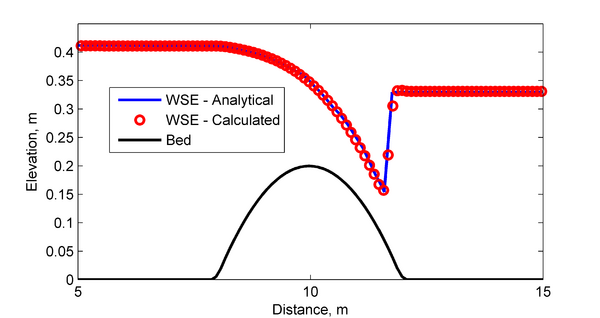Flow over a bump: Difference between revisions
No edit summary |
|||
| Line 29: | Line 29: | ||
== Model Setup == | == Model Setup == | ||
[[Image:Bump_Grid.png|thumb| | [[Image:Bump_Grid.png|thumb|right|600px| Figure 1. Computational grid.]] | ||
The computational domain is 25 m long and has a constant grid resolution of 0.1 m. A flux boundary condition is specified at the inflow boundary and a constant water level boundary condition is applied to the downstream boundary. An adaptive time between 0.1-10 seconds is applied. | The computational domain is 25 m long and has a constant grid resolution of 0.1 m. A flux boundary condition is specified at the inflow boundary and a constant water level boundary condition is applied to the downstream boundary. An adaptive time between 0.1-10 seconds is applied. | ||
Revision as of 23:35, 14 December 2010
UNDER CONSTRUCTION
Setup
The spatial domain consists of a rectangular
| (1) |
where is the bed elevation and is the horizontal distance.
Table 1. General Settings for Flow over a Bump
| Parameter | Value |
| Discharge | 0.18 m^3/s |
| Downstream water level | 0.33 m |
| Bottom friction | None |
Model Setup
The computational domain is 25 m long and has a constant grid resolution of 0.1 m. A flux boundary condition is specified at the inflow boundary and a constant water level boundary condition is applied to the downstream boundary. An adaptive time between 0.1-10 seconds is applied.
Results
A comparison between the analytical solution for water levels is compared to the calculated water levels in Figure 2. As shown in the goodness of fit statistics, the model results agree well with the analytical solution. The minimum water level is captured well, however there is a small shift in the location of the water level drop over the bump toward the downstream direction.
Table 2. Goodness of fit statistics for the water surface elevation
| Statistic | Value |
| RMSE | 0.0074 m |
| RMAE | 0.0068 m |
| R^2 | 0.991 |
| Bias | 0.0017 m |
References
- Caleffi, V., Valiani, A., and Zanni, A. (2003). "Finite volume method for simulating extreme flood events in naturalchannels," Journal of Hydraulic Research, 41(2), 167-177.




